
Pieter Brueghel the Younger or Pieter Bruegel the Younger was a Flemish painter, known for numerous copies after his father Pieter Bruegel the Elder's work as well as his original compositions. The large output of his studio, which produced for the local and export market, contributed to the international spread of his father's imagery.

Pieter Bruegel the Elder was the most significant artist of Dutch and Flemish Renaissance painting, a painter and printmaker from Brabant, known for his landscapes and peasant scenes ; he was a pioneer in making both types of subject the focus in large paintings.

Jan Brueghel the Elder was a Flemish painter and draughtsman. He was the son of the eminent Flemish Renaissance painter Pieter Brueghel the Elder. A close friend and frequent collaborator with Peter Paul Rubens, the two artists were the leading Flemish painters in the first three decades of the 17th century.
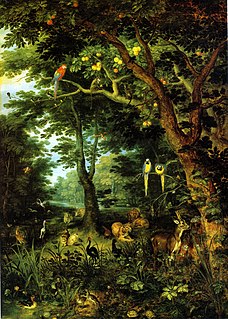
Jan Brueghel the Younger was a Flemish Baroque painter, and the son of Jan Brueghel the Elder.
Brueghel or Bruegel was the name of several Dutch/Flemish painters from the same family line:

Abraham Brueghel was a Flemish painter from the famous Brueghel family of artists. He emigrated at a young age to Italy where he played an important role in the development of the style of decorative Baroque still lifes.
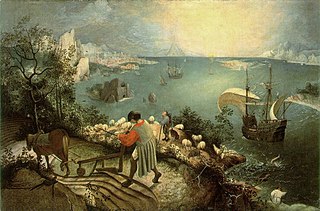
Dutch and Flemish Renaissance painting represents the 16th-century response to Italian Renaissance art in the Low Countries. These artists, who span from the Antwerp Mannerists and Hieronymus Bosch at the start of the 16th century to the late Northern Mannerists such as Hendrik Goltzius and Joachim Wtewael at the end, drew on both the recent innovations of Italian painting and the local traditions of the Early Netherlandish artists. Antwerp was the most important artistic centre in the region. Many artists worked for European courts, including Bosch, whose fantastic painted images left a long legacy. Jan Mabuse, Maarten van Heemskerck and Frans Floris were all instrumental in adopting Italian models and incorporating them into their own artistic language. Pieter Brueghel the Elder, with Bosch the only artist from the period to remain widely familiar, may seem atypical, but in fact his many innovations drew on the fertile artistic scene in Antwerp.

Jan van Kessel the Elder or Jan van Kessel (I) was a Flemish painter active in Antwerp in the mid 17the century. A versatile artist he practised in many genres including studies of insects, floral still lifes, marines, river landscapes, paradise landscapes, allegorical compositions, scenes with animals and genre scenes. A scion of the Brueghel family many of his subjects took inspiration of the work of his grandfather Jan Brueghel the Elder as well as from the earlier generation of Flemish painters such as Daniel Seghers, Joris Hoefnagel and Frans Snyders.
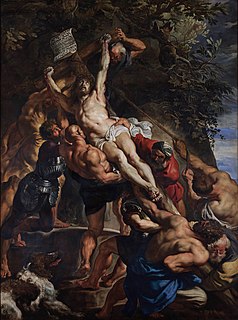
Flemish Baroque painting refers to the art produced in the Southern Netherlands during Spanish control in the 16th and 17th centuries. The period roughly begins when the Dutch Republic was split from the Habsburg Spain regions to the south with the Spanish recapturing of Antwerp in 1585 and goes until about 1700, when Habsburg authority ended with the death of King Charles II. Antwerp, home to the prominent artists Peter Paul Rubens, Anthony van Dyck, and Jacob Jordaens, was the artistic nexus, while other notable cities include Brussels and Ghent.

Ambrosius Brueghel was a Flemish painter from the famous Brueghel family of artists. Less prolific and less well-known than a number of his family members, his oeuvre is not very well understood and is believed to comprise Baroque still lifes, garland paintings as well as landscapes.
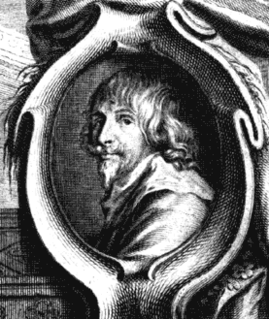
Hendrik van Steenwijck II (c.1580–1640) was a Baroque painter mostly of architectural interiors, but also of biblical scenes and still lifes.
A tronie is a common type, or group of types, of works common in Dutch Golden Age painting and Flemish Baroque painting that shows an exaggerated facial expression or a stock character in costume. It is related to the French word “tronche” which is slang for “mug” or head.

Pieter van Avont or Peter van Avont, (1600–1652) was a Flemish painter, draughtsman and printmaker known for his religious scenes and cabinet paintings often including nude children and putti. Van Avont was a frequent collaborator with many leading painters in Antwerp.

Adriaen or Adriaan van Stalbemt or Adriaen van Stalbempt was a Flemish painter and printmaker who is known for his landscapes with religious, mythological and allegorical scenes. He was also a gifted figure painter who was regularly invited to paint the staffage in compositions of fellow painters.
Diego Duarte or Jacob Duarte (1612–1691) was a 17th-century Portuguese jeweler, banker, composer, organist and art collector living in Antwerp, who owned paintings by Jan Vermeer, Raphael and others.

The Five Senses is a set of allegorical paintings created at Antwerp in 1617–18 by Jan Brueghel the Elder and Peter Paul Rubens, with Brueghel being responsible for the settings and Rubens for the figures. They are now in the Prado Museum in Madrid. They are all painted in oils on wood panel, approximately 65 by 110 centimetres in dimensions.

The Garden of Eden with the Fall of Man or The Earthly Paradise with the Fall of Adam and Eve is a 1617 painting by Peter Paul Rubens (figures) and Jan Brueghel the Elder. It is housed in the Mauritshuis, Netherlands. The painting depicts the moment just before the consumption of forbidden fruit and the fall of man.
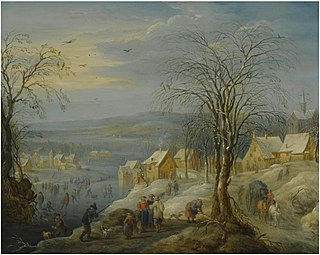
Carel Beschey or Karel Beschey was a Flemish painter and draughtsman who mainly painted landscapes that were in the style of, or inspired by, the Flemish masters of the previous century and in particular Jan Brueghel the Elder.
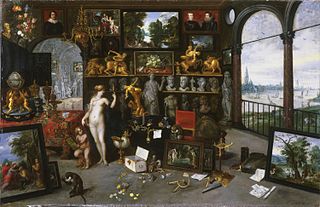
Allegory of Sight is an oil painting by Jan Brueghel the Younger. The painting showcases varied objects associated with sight, the arts, and navigation. The painting was heavily influenced by The Five Senses, a series of allegorical paintings done by the younger Brueghel's father, Jan Brueghel the Elder.

















